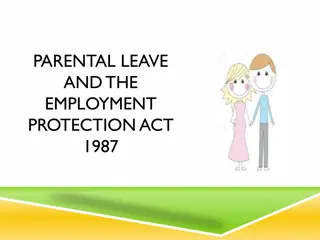Social Protection of Employees in EU: Historical Backgrounds and Directives
In this informative content, JUDr. Jana Komendov, Ph.D., delves into the social protection of employees in the European Union. Topics covered include historical backgrounds, laws for safeguarding employees in case of company transfers or insolvency, and the scope of application. Key directives such as Council Directive 2001/23/EC are discussed to ensure the rights of employees amidst structural changes in undertakings. The content emphasizes the need for a minimum standard of employee protection across EU Member States to prevent social dumping and ensure a fair labor market.
Download Presentation

Please find below an Image/Link to download the presentation.
The content on the website is provided AS IS for your information and personal use only. It may not be sold, licensed, or shared on other websites without obtaining consent from the author.If you encounter any issues during the download, it is possible that the publisher has removed the file from their server.
You are allowed to download the files provided on this website for personal or commercial use, subject to the condition that they are used lawfully. All files are the property of their respective owners.
The content on the website is provided AS IS for your information and personal use only. It may not be sold, licensed, or shared on other websites without obtaining consent from the author.
E N D
Presentation Transcript
Social Protection of Employees JUDr. Jana Komendov , Ph.D.
Programme Historical backrounds, Protection of employees in the event od transfer of the undertaking or part of the undertaking, Protection of employees in the event of their employer's insolvency, Protection of employees in the event of collective dismissals
Historical Backrounds Traditional part of the EU social policy regulated since 1970s, Purpose elimination of social dumping between undertakings from EU Member States based on different level of employees' protection, Approximation of laws of EU Member States minimum standard of protection of employees guaranteed by all national laws of EU Member States Differences in national legislation could have a direct effect on the functioning of the internal market Golden age of EU labour law The protection of employees in the event of transfer of undertaking, insolvency of their employer, collective redundancies (dismissals)
Protection of Employees in the Event of Transfer of Undertaking or Part of the Undertaking Secondary law - Council Directive 2001/23/EC on the approximation of the laws of the Member States relating to the safeguarding of employees' rights in the event of transfers of undertakings, businesses or parts of undertakings or businesses. (replaced the former Directive 77/187) Purpose to guarantee protection of employee's rights in the event of changes in structures of undertakings in all Member States
Scope of Application 1. Material scope of application - any transfer of an undertaking, business, or part of an undertaking or business to another employer as a result of a legal transfer or merger. 2. Personal scope of application - public and private undertakings engaged in economic activities whether or not they are operating for gain. Exclusion from the scope of application - an administrative reorganisation of public administrative authorities, or the transfer of administrative functions between public administrative authorities, 3. Local scope of application - the tirective shall apply where and in so far as the undertaking, business or part of the undertaking or business to be transferred is situated within the territorial scope of the Treaty. Seagoing vessels are excluded.
Prohibition of Exclusion Prohibition of exclusion from the scope of application on the grounds of: Existence of part-time contract or employment relationship Existence of fixed-term employment contract Performing of temporary work
Definitions Transfer - a transfer of an economic entity which retains its identity, meaning an organised grouping of resource which has the objective of pursuing an economic activity, whether or not that activity is central or ancillary, Transferor - any natural or legal person who, by reason of a transfer ceases to be the employer in respect of the undertaking, business or part of the undertaking or business, Transferee - any natural or legal person who, by reason of a transfer becomes the employer in respect of the undertaking, business or part of the undertaking or business
Forms of Protection of Employees Safeguarding of employees' rights and duties arising from labour relations from a transferor to a transferee, Protection against dismissal on the grounds of transfer of the undertaking or part of the undertaking, Protection of position of employee's representatives existing before the date of transfer, The employee's right to information and consultation
Protection of Employees in the Event of their Employer s Insolvency Secondary law - Directive 2008/94/EC of the European Parliament and of the Council of 22 October 2008 on the protection of employees in the event of the insolvency of their employer replaced the previous directive (80/987) Purpose - to guarantee minimum standard of protection of employee's rights in the event if the employer's insolvency
Scope of Appliction Employees claims arising from contracts of employment or employment relationships and existing against employers who are in a state of insolvency State of insolvency - where a request has been made for the opening of collective proceedings based on insolvency of the employer, as provided for under the laws, regulations and administrative provisions of a Member State, and involving the partial or total divestment of the employer s assets and the appointment of a liquidator or a person performing a similar task, and the authority which is competent pursuant to the said provisions has: (a) either decided to open the proceedings; or (b) established that the employer s undertaking or business has been definitively closed down and that the available assets are insufficient to warrant the opening of the proceedings. Terms employer, employee, remuneration shall be defined in national law
Prohibition of Ecxlusion from the Scope of Application Prohibition of exclusion of employees with: fixed-term contract, part-time contract and temporary contract Prohibition for Member States to set a minimum duration for the contract of employment or the employment relationship in order for employees to qualify for their claims
Forms of Protection Obligation of the Member States to establish an institution that guarantees outstanding claims of employees resulting from contracts of employment or employment relationships including severance pay on termination of employment relationship if proveded by national legislation, Obligation of Member States to ensure that non-payment of compulsory contributions due from the employer, before the onset of his insolvency, to their insurance institutions under national statutory social security schemes does not adversely affect employees benefit entitlement
Protection of Employees in the Event of Collective Dismissals Secondary Law - Council Directive 98/59/EC of 20 July 1998 on the approximation of the laws of the Member States relating to collective redundancies replaced the Directive 75/129/EEC, Purpose to approximate procedure for collective redundancise in EU Member States
Exclusion from the Scope of Application The provisions of the Directive do not apply to: Redundancies effected under employment contracts for fixed-term, except where such redundancies take place prior to the date of expiry or the completion of such contracts Employees of public authorities bodies or establishments governed by public law The crews of seagoing vessels
Collective Redundancy - Definition Possibility of a Member to define collective redundancy collective redundancies` means dismissals effected by an employer for one or more reasons not related to the individual workers concerned where, according to the choice of the Member States, the number of redundancies is: 1. either, over a period of 30 days - at least 10 in establishments normally employing more than 20 and less than 100 workers, - at least 10 % of the number of workers in establishments normally employing at least 100 but less than 300 workers, - at least 30 in establishments normally employing 300 workers or more 2. Over a period of 90 days, at least 20, whatever the number of workers normally employed in the establishments in question
Forms of Protection of Employees The rtight of employee's representatives to information and consultation before the effecting the collective redundancies, The rtight of employee's representatives to information and consultation after effecting the collective redundancies, The obligation of an employer to inform competent public authority in writing of any projected collective redundancies, Projected collective redundancies notified to the competent public authority shall take effect not earlier than 30 days after the notification























